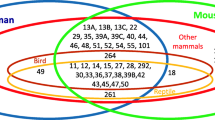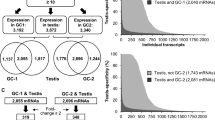Summary
In order to identify novel genes involved in spermatogenesis, testis cDNA samples from Balb/C mice of different postnatal days were hybridized with the whole mouse genome Affymetrix chip to screen the testis-specific genes. The characteristics of the selected genes were analyzed by RT-PCR as well as other bioinformatic tools. A novel differentially expressed testis-specific gene (GenBank Accession No: NM_029042) in the developmental stages of testes was identified, and named TSCPA. Cellular mapping prediction of TSCPA indicated that its protein was probably expressed in nuclei, and one putative domain (aa 332–377) was anchoring domain of cAMP-dependent type II PK. The result of subcellular localization of GFP-TSCPA fusion protein in Cos-7 cells showed that TSCPA protein was expressed in nuclei. RT-PCR analysis revealed that TSCPA was expressed specifically in mouse and human testis. TSCPA gene was expressed weakly in 21-day-old mouse testis and the expression was increased gradually from 38th day to 6th month of mouse testes. No expression of hTSCPA was found in cryptorchidism and Sertoli-cell-only syndrome patients. It was concluded that the expression profile of TSCPA in human and mice indicated that TSCPA might play an important role in spermatogenesis.
Similar content being viewed by others
References
Tanaka H, Baba T. Gene expression in spermiogenesis. Cell Mol Life Sci, 2005,62(3):344–354
Blocher S, Fink L, Bohle RM, et al. CREM activator and repressor isoform expression in human male germ cells. Int J Androl, 2005,28(4):215–223
Widlak W, Benedyk K, Vydra N, et al. Expression of a constitutively active mutant of heat shock factor 1 under the control of testis-specific hst70 gene promoter in transgenic mice induces degeneration of seminiferous epithelium. Acta Biochim Pol, 2003,50(2):535–541
Kimmins S, Kotaja N, Davidson I, et al. Testis-specific transcription mechanisms promoting male germ-cell differentiation. Reproduction, 2004,128(1):5–12
Pietrowska M, Widlak P. Characterization of a novel protein that specifically binds to DNA modified by N-acetoxy-acetylaminofluorene and cis-diamminedi chloro platinum. Acta Biochim Pol, 2005,52(4):867–874
Pinto PI, Teodosio HR, Galay-Burgos M, et al. Identification of estrogen-responsive genes in the testis of sea bream (Sparus auratus) using suppression subtractive hybridization. Mol Reprod Dev, 2006,73(3):318–329
Grimes SR. Testis-specific transcriptional control. Gene, 2004,343(1):11–22
Anway MD, Li Y, Ravindranath N. Expression of testicular germ cell genes identified by differential display analysis. J Androl, 2003,24(2):173–184
Nie DS, Xiang Y, Wang J, et al. Identification of a novel testis-specific gene mtLR1, which is expressed at specific stages of mouse spermatogenesis. Biochem Biophys Res Commun, 2005,328(4):1010–1018
Sha J, Zhou Z, Li J, et al. Identification of testis development and spermatogenesis-related genes in human and mouse testis using cDNA arrays. Mol Hum Reprod, 2002,8(6):511–517
Xiao J, Xu M, Li J, et al. NYD-SP6, a novel gene potentially involved in regulating testicular development/spermatogenesis. Biochem Biophys Res Commun, 2002,291(1):101–110
Xu M, Xiao J, Chen J, et al. Identification and characterization of a novel human testis-specific Golgi protein, NYD-SP12. Mol Hum Reprod, 2003,9(1):9–17
Cheng LJ, Li JM, Chen J, et al. NYD-SP16, a novel gene associated with spermatogenesis of human testis. Biol Reprod, 2003,68(1):190–198
Zhou Z, Ren X, Huang X, et al. SMYD3-NY, a novel SMYD3 mRNA transcript variant, may have a role in human spermatogenesis. Ann Clin Lab Sci, 2005,35(3): 270–277
Beissbarth T, Borisevich I, Horlein A, et al. Analysis of CREM-dependent gene expression during mouse spermatogenesis. Mol Cell Endocrinol, 2003,212(1–2):29–39
Cardone L, de Cristofaro T, Affaitati A, et al. A-kinase anchor protein 84/121 are targeted to mitochondria and mitotic spindles by overlapping amino-terminal motifs. J Mol Biol, 2002, 320(3):663–675
Anway MD, Ravindranath N, Dym M, et al. Identification of a murine testis complementary DNA encoding a homolog to human A-kinase anchoring protein-associated sperm protein. Biol Reprod, 2002,66(6):1755–1761
Fire A, Xu S, Montgomery MK, et al. Potent and specific genetic interference by double-stranded RNA in Caenorhabditis elegans. Nature, 1998,391(6669):806–811
Author information
Authors and Affiliations
Corresponding author
Additional information
This project was supported by grants from Natural Science Foundation of Guangdong Province, China (No. 7008952, No. 7300931), and National Natural Sciences Foundation of China (No. 30700824).
Rights and permissions
About this article
Cite this article
Yu, Z., Wu, B., Tang, A. et al. Expression profile of a novel germ cell-specific gene, TSCPA, in mice and human. J. Huazhong Univ. Sci. Technol. [Med. Sci.] 29, 535–539 (2009). https://doi.org/10.1007/s11596-009-0502-9
Received:
Published:
Issue Date:
DOI: https://doi.org/10.1007/s11596-009-0502-9




